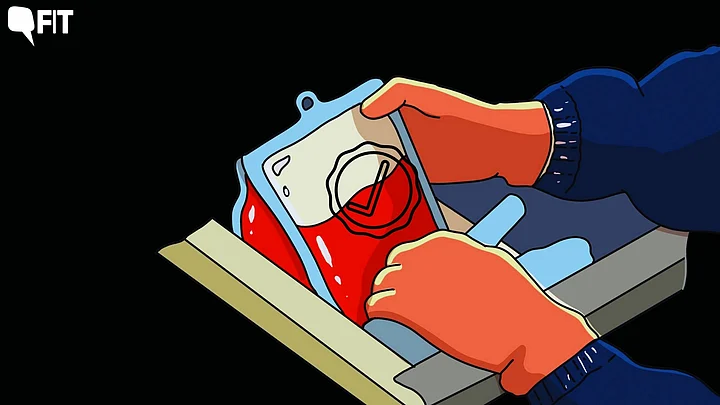Have you ever wondered what happens to the blood you donate?
This World Blood Donor Day, FIT takes you on an interactive journey following a bag of donated blood from the moment you step into a blood donation camp or facility to the time you save a life.
Click on the interactive below for the full experience.
For this story, FIT sought the inputs of Dr Sangeeta Agarwal, Transfusion Medicine, Additional Director, Fortis Memorial Research Institute.
Step 1: Screening
First, when you decide to donate blood, you are given a questionnaire to fill. Here you fill in your general information, some medical history, and give written consent to donating your blood.
"This gives us clarity of whether the person is comfortable, and has no reservations about giving blood,"says Dr Sangeeta Agarwal, Transfusion Medicine, Additional Director, Fortis Memorial Research Institute.
After this, your medical fitness is checked – This includes your blood pressure, temperature, and weight. This is done because the amount of blood taken will depend on your weight.
Step 2: Donation
If you weigh less than 55 kg, then around 350 ml of blood is collected, and if you weigh more than 55 kg, then 450 ml is taken.
Once you give blood, you're given some replenishments like a banana or a glucose drink. You are kept under observation for a few minutes before you're allowed to leave.
The collected blood is stored in blood bags with anticonvulsants to prevent the blood from clotting.
Step 3: Testing
After the blood is collected, it is now moved to test tubes for processing. This starts with screening of the blood for possible infections.
Donated blood is, as a standard practice by law, tested for HIV, Hepatitis B, Hepatitis C, malarial parasites, and syphilis, and an antibody screening is done.
At this stage, the blood group of the donated blood is also determined.
Step 4: Separation
After this, and sometimes, while the testing is underway, the blood is loaded up into a centrifuge machine that separates it into different components – Red blood cells, plasma, and platelets.
This is done so that the use of the blood can be optimised and patients can be given what they need.
"We don't use the blood as a whole. For example, if a patient has low haemoglobin levels, or a patient is aneimic, we will only give red cells. If the platelets are low, we give the component which has platelets."Dr Sangeeta Agarwal, Transfusion Medicine, Additional Direcot, Fortis Memorial Research Institute
Step 5: Storage and Distribution
Once the testing, grouping and labelling are done, the different components are kept in storage units set to the temperature requirement of each component.
E.g. plasma will be stored at -30 °C, platelets at around 20 to 24 °C etc and need to be constantly shaking.
When a requirement for a particular component comes in, units of it are issued accordingly and distributed.
Step 6: Transfusion
Congratulations! The blood you donated can now save a life! In fact, one donation can save up to 3 lives.
Blood cannot be manufactured, which makes it an invaluable resource.
"So, when you get blood from a blood bank, it isn't the blood that you're paying for, but all this testing, processing and storage required to ensure safety,"says Dr Agarwal.
"People often feel like their contribution doesn't matter. They think, 'why should I give when there are so many people in the world who can give'," says Dr Agarwal, adding, there are also those who think they will step up when their own relatives or friends need it, but don't feel the need to go out of their way to donate blood for strangers.
"But there are so many people who are not able to find enough people for their recurring blood requirements, especially cancer patients, kidney faliure patients on dialysis, and patients of thalassaemia."Dr Sangeeta Agarwal, Transfusion Medicine, Additional Direcot, Fortis Memorial Research Institute

